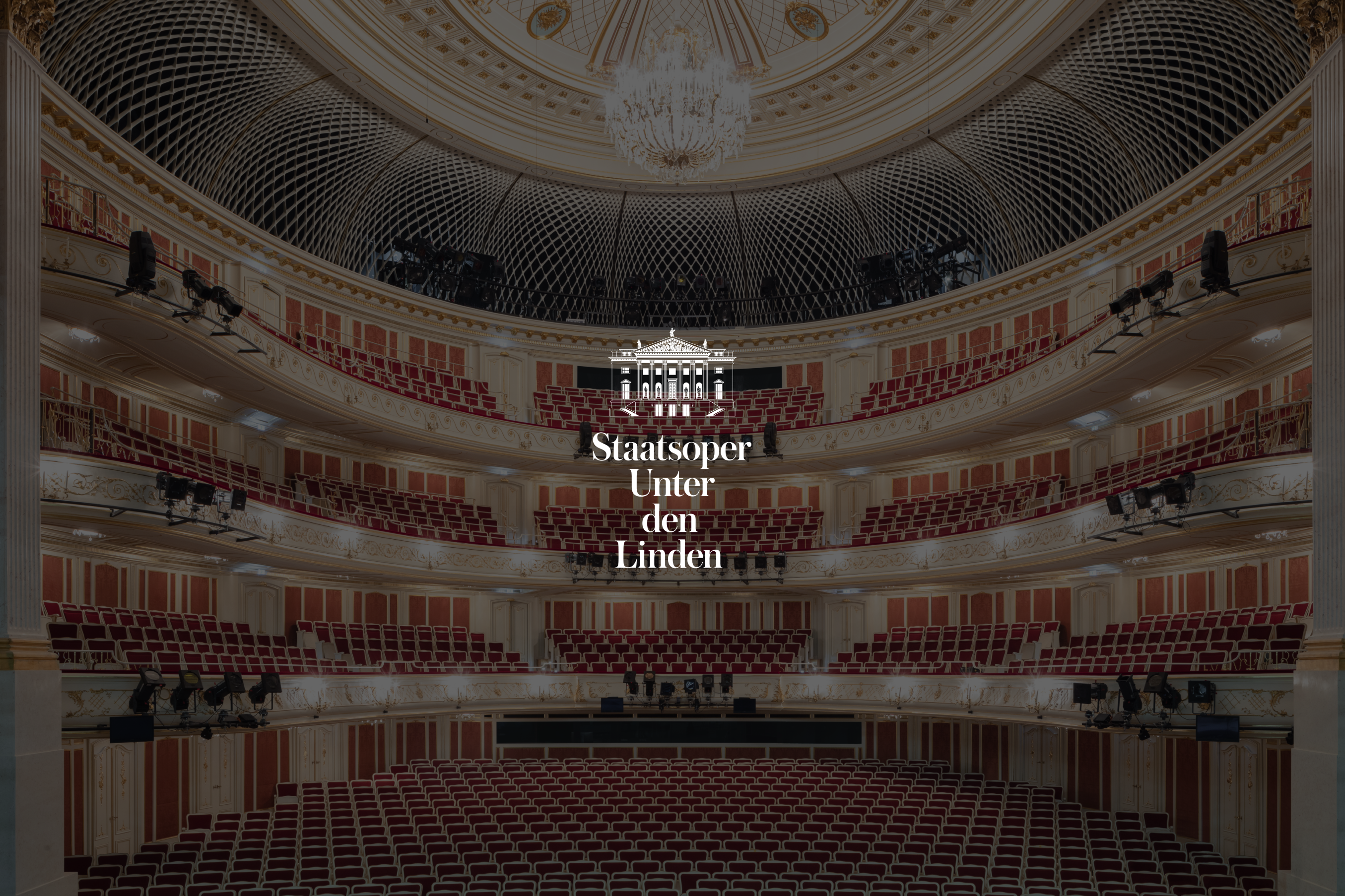Staatsoper Unter den Linden
The Magic Flute (Everding)
Opera
Unter den Linden 7, 10117 Berlin
Wolfgang Amadeus Mozart

© Monika Rittershaus

© Monika Rittershaus

© Monika Rittershaus

© Monika Rittershaus

© Monika Rittershaus

© Monika Rittershaus

© Monika Rittershaus

© Monika Rittershaus

© Monika Rittershaus
Description
It is one of the classics in the Staatsoper’s repertoire: August Everding’s production of Wolfgang Amadeus Mozart’s »The Magic Flute«. The production is unique for its reconstruction of Karl Friedrich Schinkel’s 1816 set design for what was then the Berlin Court Opera on Unter den Linden – including the legendary starry sky for the Queen of the Night, which has become an icon of scenography and continues to enchant audiences.
However, director Everding’s production was no museum piece: he brought to life the world portrayed on stage – which was based on almost two-hundred-year-old designs – through a timeless, spirited staging, which premiered at the Staatsoper in 1994, but remains every bit as witty and humorous today. Prince Tamino is saved from a giant serpent at the last minute by the three ladies of the Queen of the Night. The ladies then show him a picture of the queen’s daughter, Pamina, and he immediately falls in love with her. Together with the happy-go-lucky bird-catcher Papageno, he sets off on a journey to find his love, who is – as he discovers – being held captive by the sun priest Sarastro. In order to prove themselves worthy of the women they love, Tamino and Papageno must pass various difficult trials. Alongside the new production of »The Magic Flute« by Yuval Sharon, the Everding production will continue to enrich the Staatsoper’s repertoire. The direct comparison offered by two productions of the same work invites audiences to observe the opera from two different perspectives.
SYNOPSIS
Background
In a mythical past, a king and queen ruled together over a kingdom of day and night. Their daughter was called Pamina. When the king died, he gave his power – symbolized by the mighty circle of the sun – not to the queen, but to the Brotherhood headed by Sarastro, thereby dividing the realm of light and shadow in two. After the king’s death, however, his wife attempted to win back the power she had lost as the Queen of the Night. In order to remove Pamina from her mother’s negative influence, Sarastro has had her kidnapped.
Act One
While hunting, the young prince Tamino is lured into the realm controlled by the Queen of the Night and threatened by a monster. Fearing for his life, he loses consciousness. The Three Ladies who attend the Queen of the Night quarrel over the unconscious young man. When the prince awakes, the bird catcher Papageno tells him where he is. On the queen’s orders, the Three Ladies give Tamino a portrait of the princess Pamina, and he falls instantly and deeply in love. The queen attempts to use this love to recover Pamina and, with her, the powerful circle of the sun from Sarastro. Tamino is determined to free Pamina from Sarastro. Papageno is told to accompany him, and both are equipped with magic instruments, a flute and a set of bells. Three Boys are to guide them as good spirits. In the meantime, Pamina attempts to flee Sarastro’s control in order to escape the cruel slave overseer Monostatos. Papageno, however, finds her and tells her that Tamino loves her, and they flee together. When Tamino meets the Speaker of the Brotherhood at the gates of the temple, he begins to doubt what he has heard of Sarastro’s evil intentions. In his uncertainty, he turns to the invisible higher powers and, for the first time, discovers his flute’s magic powers. Pamina and Papageno’s attempt to flee is thwarted by the arrival of Sarastro, but Pamina decides to tell Sarastro the truth. She and Tamino meet. Sarastro has Tamino and Papageno brought to the Temple of Wisdom. As a woman, Pamina cannot accompany them.
Act Two
Sarastro asks the members of the Order to let Tamino face the trials that will initiate him into the Brotherhood and, at the same time, announces that he intends for Pamina and Tamino to wed. As their first trial, Tamino and Papageno are forbidden to speak, an utter impossibility for Papageno. The Queen of the Night sees that her plans are being foiled by Sarastro. She forces her way into the temple and calls on Pamina to kill Sarastro. Sarastro, however, uses humanity and forgiveness to fight the queen’s desire for vengeance. The Three Boys return to Tamino and Papageno the magic instruments that were taken from them before their admission to the temple. Pamina cannot understand Tamino’s silence and doubts his love. She decides to kill herself and is stopped by the Three Boys at the last moment. In the end, the two lovers pass the final, decisive test in the temple of fire and water together. In the meantime, Papageno, too, decides to kill himself because the Papagena he had found at last has been taken from him. Here, too, the Three Boys arrive to save him. Monostatos allies himself with the Queen of the Night, but their attack is thwarted and the sun banishes the darkness. Together with the Queen of the Night, Sarastro is able to turn over the mighty circle of the sun to the new king and queen, Tamino and Pamina.
---
Die Zauberflöte - Opera in two acts by Wolfgang Amadeus Mozart
Libretto by Emanuel Schikaneder
In German language with German and English surtitles
However, director Everding’s production was no museum piece: he brought to life the world portrayed on stage – which was based on almost two-hundred-year-old designs – through a timeless, spirited staging, which premiered at the Staatsoper in 1994, but remains every bit as witty and humorous today. Prince Tamino is saved from a giant serpent at the last minute by the three ladies of the Queen of the Night. The ladies then show him a picture of the queen’s daughter, Pamina, and he immediately falls in love with her. Together with the happy-go-lucky bird-catcher Papageno, he sets off on a journey to find his love, who is – as he discovers – being held captive by the sun priest Sarastro. In order to prove themselves worthy of the women they love, Tamino and Papageno must pass various difficult trials. Alongside the new production of »The Magic Flute« by Yuval Sharon, the Everding production will continue to enrich the Staatsoper’s repertoire. The direct comparison offered by two productions of the same work invites audiences to observe the opera from two different perspectives.
SYNOPSIS
Background
In a mythical past, a king and queen ruled together over a kingdom of day and night. Their daughter was called Pamina. When the king died, he gave his power – symbolized by the mighty circle of the sun – not to the queen, but to the Brotherhood headed by Sarastro, thereby dividing the realm of light and shadow in two. After the king’s death, however, his wife attempted to win back the power she had lost as the Queen of the Night. In order to remove Pamina from her mother’s negative influence, Sarastro has had her kidnapped.
Act One
While hunting, the young prince Tamino is lured into the realm controlled by the Queen of the Night and threatened by a monster. Fearing for his life, he loses consciousness. The Three Ladies who attend the Queen of the Night quarrel over the unconscious young man. When the prince awakes, the bird catcher Papageno tells him where he is. On the queen’s orders, the Three Ladies give Tamino a portrait of the princess Pamina, and he falls instantly and deeply in love. The queen attempts to use this love to recover Pamina and, with her, the powerful circle of the sun from Sarastro. Tamino is determined to free Pamina from Sarastro. Papageno is told to accompany him, and both are equipped with magic instruments, a flute and a set of bells. Three Boys are to guide them as good spirits. In the meantime, Pamina attempts to flee Sarastro’s control in order to escape the cruel slave overseer Monostatos. Papageno, however, finds her and tells her that Tamino loves her, and they flee together. When Tamino meets the Speaker of the Brotherhood at the gates of the temple, he begins to doubt what he has heard of Sarastro’s evil intentions. In his uncertainty, he turns to the invisible higher powers and, for the first time, discovers his flute’s magic powers. Pamina and Papageno’s attempt to flee is thwarted by the arrival of Sarastro, but Pamina decides to tell Sarastro the truth. She and Tamino meet. Sarastro has Tamino and Papageno brought to the Temple of Wisdom. As a woman, Pamina cannot accompany them.
Act Two
Sarastro asks the members of the Order to let Tamino face the trials that will initiate him into the Brotherhood and, at the same time, announces that he intends for Pamina and Tamino to wed. As their first trial, Tamino and Papageno are forbidden to speak, an utter impossibility for Papageno. The Queen of the Night sees that her plans are being foiled by Sarastro. She forces her way into the temple and calls on Pamina to kill Sarastro. Sarastro, however, uses humanity and forgiveness to fight the queen’s desire for vengeance. The Three Boys return to Tamino and Papageno the magic instruments that were taken from them before their admission to the temple. Pamina cannot understand Tamino’s silence and doubts his love. She decides to kill herself and is stopped by the Three Boys at the last moment. In the end, the two lovers pass the final, decisive test in the temple of fire and water together. In the meantime, Papageno, too, decides to kill himself because the Papagena he had found at last has been taken from him. Here, too, the Three Boys arrive to save him. Monostatos allies himself with the Queen of the Night, but their attack is thwarted and the sun banishes the darkness. Together with the Queen of the Night, Sarastro is able to turn over the mighty circle of the sun to the new king and queen, Tamino and Pamina.
---
Die Zauberflöte - Opera in two acts by Wolfgang Amadeus Mozart
Libretto by Emanuel Schikaneder
In German language with German and English surtitles
Cast
Eva Ollikainen
Musical Director
August Everding
Director
---
Friedrich Hamel
Sarastro
Andrés Moreno García
Tamino
Kathryn Lewek
Queen of the Night
Evelin Novak
Pamina
Anna Kissjudit
Three ladies
Carles Pachon
Papageno
Serafina Starke
Papagena
Arttu Kataja
Speaker
Florian Hoffmann
Monostatos
Kim Schrader
1st priest
Arttu Kataja
2nd priest
Stephan Rügamer
1. Geharnischter
Manuel Winckhler
2. Geharnischter
Solisten des Kinderchors der Staatsoper
3 boys
---
Katharina Lang
Scenic Rehearsal
Fred Berndt
Set Design
Dorothée Uhrmacher
Costumes
Franz Peter David
Light
---
Staatsopernchor
Kinderchor der Staatsoper
Staatskapelle Berlin
Dates
Staatsoper Unter den Linden
Unter den Linden 7, 10117 Berlin
To enable Google Maps please accept functional cookies.

Your new app
ClassicCard
Get the free app directly on your mobile:
- Browse and book all concerts, operas and ballet events in Berlin
- Save up to 90% thanks to our permanently low prices
- Network with the community and share your experience




